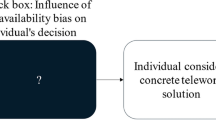Abstract
This case study investigated university members’ use of and resistance to a communication information technology system in a higher education organization. This case study utilized the technology enactment framework to examine structure enactment in university members’ technology use and resistance. We found that the following structures were enacted in organizational members’ interactions with the system: maximum use, enhancing teaching, augmenting service, limited use, and resistance. Besides providing empirical evidence to the enactments of inertia, application, and change, this case study added a new enactment type, i.e., resistance, to the existing enactment typology. The findings provided empirical support to the structuration principle—the enabling and constraining nature of structure. Important implications were addressed with respect to adoption and implementation of technology in higher education institutions.
Similar content being viewed by others
Explore related subjects
Discover the latest articles, news and stories from top researchers in related subjects.References
Applegate, L. M., McFarlan, F. W., & Mckenney, J. L. (1996). Corporate information systems management: Text and cases. Boston, MA: McGraw-Hill.
Bedeian, A. (2007). Even if the tower is “ivory”, it isn’t “white:” Understanding the consequences of faculty cynicism. Academy of Management Learning & Education, 6, 9–32.
Bennett, L. (2001). Technology standards for the preparation of teachers. International Journal of Social Education, 15, 1–11.
Blackboard.com retrieved on October 23, 2009.
Carnevale, D. (2006). Online. Chronicle of Higher Education, 52(24), A37.
Chan, S. C. H., & Ngai, E. W. T. (2007). A qualitative study of information technology adoption: How ten organizations adopted web-based training. Information Systems Journal, 17, 289–315.
Chapman, B. F., & Heath-Camp, B. (2005). Factors influencing the computer technology adoption rate of business teacher educators. Business Education Digest, 14, 15–30.
Duhaney, D. C. (2001). Teacher education: Preparing teachers to integrate technology. International Journal of Instructional Media, 28, 23–30.
Eisenberg, E. M., Murphy, A., & Andrews, L. (1998). Openness and decision making in the search for a university provost. Communication Monographs, 65, 1–23.
Emerson, R. M., Fretz, R. I., & Shaw, L. L. (1995). Writing ethnographic fieldnotes. Chicago: University of Chicago Press.
Eynon, R. (2008). The use of the world wide web in learning and teaching in higher education: Reality and rhetoric. Innovations in Education and Teaching International, 45, 15–23.
Fountain, J. E. (2001). Building the virtual state: Information technology and institutional change. Washington, DC: Brookings Institute.
Fulk, J., Schmitz, J., & Steinfield, C. (1990). A social influence model of technology use. In J. Fulk & C. Steinfield (Eds.), Organizations and communication technology (pp. 117–140). Newbury Park, CA: Sage.
Gerdes, C., & Kuhr, P. (2004). The Blackboard course makeover of ethics and the media. TechTrends, 48(5), 71–74.
Giddens, A. (1979). Central problems in social theory: Action, structure, and contradiction in social analysis. Berkley: University of California Press.
Giddens, A. (1984). The constitution of society: Outline of the theory of structuration. Cambridge, MA: Polity.
Groves, M. M., & Zemel, P. C. (2000). Instructional technology adoption in higher education: An action research case study. International Journal of Instructional Media, 27, 57–65.
Jablin, F. M. (2001). Organizational entry, assimilation, and disengagement/exit. In F. M. Jablin & L. L. Putnam (Eds.), The new handbook of organizational communication: Advances in theory, research, and methods (pp. 732–818). Thousand Oaks, CA: Sage.
Jefferies, P., Grodzinsky, F., & Griffin, J. (2003). Advantages and problems in using information communication technologies to support the teaching of a multi-institutional computer ethics course. Journal of Educational Media, 28, 191–202.
Kirkpatrick, G. (2005). Online ‘chat’ facilities as pedagogic tools. Active Learning in Higher Education, 6, 145–159.
Lapointe, L., & Rivard, S. (2005). A multilevel model of resistance to information technology implementation. MIS Quarterly, 29, 461–491.
Larkin, T. L., & Belson, S. I. (2005). Blackboard technologies: A vehicle to promote student motivation and learning in physics. Journal of STEM Education, 6, 14–27.
Myers, M. D., & Newman, M. (2007). The qualitative interview in IS research: Examining the craft. Information and Organization, 17, 2–26.
Orlikowski, W. (2000). Using technology and constituting structures: A practice lens for studying technology in organizations. Organization Science, 11, 404–428.
Roberts-DeGennaro, M., Brown, C., Min, J. W., & Siegel, M. (2005). Using an online support site to extend the learning to a graduate field practicum in the United States. Social Work Education, 24, 327–342.
Sitkin, S. B., Sutcliffe, K. M., & Barrios-Choplin, J. R. (1992). A dual-capacity model of communication media choice in organizations. Human Communication Research, 18, 563–598.
Vannatta, R. A. (2000). Evaluation to planning: Technology integration in a school of education. Journal of Technology and Teacher Education, 8, 231–246.
Weick, K. (1976). Educational organizations as loosely coupled systems. Administrative Science Quarterly, 21, 1–19.
Yao, J. E., Xu, X., Liu, C., & Lu, J. (2003). Organizational size: A significant predictor of IT innovation adoption. Journal of Computer Information Systems, 43, 76–82.
Author information
Authors and Affiliations
Corresponding author
Rights and permissions
About this article
Cite this article
Lin, C., Singer, R. & Ha, L. Why university members use and resist technology? A structure enactment perspective. J Comput High Educ 22, 38–59 (2010). https://doi.org/10.1007/s12528-010-9028-1
Published:
Issue Date:
DOI: https://doi.org/10.1007/s12528-010-9028-1




